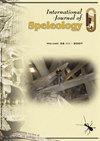利用叶绿素a荧光监测Nerja洞穴微藻和蓝藻生物膜的光合活性(西班牙马拉加)
IF 1.3
4区 地球科学
Q3 GEOSCIENCES, MULTIDISCIPLINARY
引用次数: 0
摘要
通过对Nerja洞穴中最常见的光合生物膜的体内叶绿素a (Chl a)荧光的持续监测,以及将辐照度作为与洞穴研究相关的新环境变量,对Nerja洞穴中最常见的光合生物膜进行表征,使我们对洞穴生物膜的光合模式有了更深入的了解。有效量子产率(ΔF/Fm)和相对电子传递率(rETR)是在有光期间测定的,而最大量子产率(Fv /Fm)是在黑暗期间测定的。夏季光合产量和生产力的增加与相对湿度、空气二氧化碳浓度和气温等环境变量的最高值有关。根据辐照度,研究的生物膜在洞穴照明下生长最佳,与类似的研究相比被认为是低的,也许是因为它们也可以混合营养生长。此外,随着光照强度的增加,ΔF/Fm′和rETR在春季均下降,说明洞内生物膜的光合速率受到光抑制,而在夏季,光合速率与光照强度呈正相关,说明洞内生物膜的光抑制减弱,这可能是由于环境变量值的增加引起了光抑制程度的减轻。本文章由计算机程序翻译,如有差异,请以英文原文为准。
Monitoring photosynthetic activity using in vivo chlorophyll a fluorescence in microalgae and cyanobacteria biofilms in the Nerja Cave (Malaga, Spain)
The characterization of the most common photosynthetic biofilms in the Nerja Cave by the continuous monitoring of the in vivo chlorophyll a (Chl a) fluorescence and the incorporation of the irradiance as a new environmental variable related to previous studies in the cave, have allowed us to improve our knowledge about the photosynthetic pattern of the biofilms of the cave. Effective quantum yield (ΔF/Fm) and relative electron transport rate (rETR) were determined during periods of the light, whereas the maximal quantum yield (Fv /Fm) was determined during dark periods. Increases in the photosynthetic yields and productivity in summer period were found related to the highest values of the environmental variables, such as relative humidity, air carbon dioxide concentration and air temperature. According to the irradiance, the studied biofilms had an optimal growth with cave lighting, considered low in comparison with similar studies, perhaps because they can grow mixotrophically too. Moreover, when the irradiance increased, both the ΔF/Fm′ and the rETR decreased in springtime, suggesting photoinhibition of the photosynthetic yield in the biofilms within the cave, whereas in the summertime, the photosynthetic yield had a positive correlation with the irradiance, suggesting a decreased of the photoinhibition, possibly due to the increase of the environmental variables values which provokes an alleviate on the extent of photoinhibition.
求助全文
通过发布文献求助,成功后即可免费获取论文全文。
去求助
来源期刊

International Journal of Speleology
地学-地球科学综合
CiteScore
3.10
自引率
23.10%
发文量
12
审稿时长
>12 weeks
期刊介绍:
The International Journal of Speleology has the aim to get cave and karst science known to an increasing number of scientists and scholars. The journal therefore offers the opportunity to all scientists working in and on karst to publish their original research articles or their review papers in an open access, high quality peer reviewed scientific journal at no cost. The journal offers the authors online first, open access, a free PDF of their article, and a wide range of abstracting and indexing services.
 求助内容:
求助内容: 应助结果提醒方式:
应助结果提醒方式:


